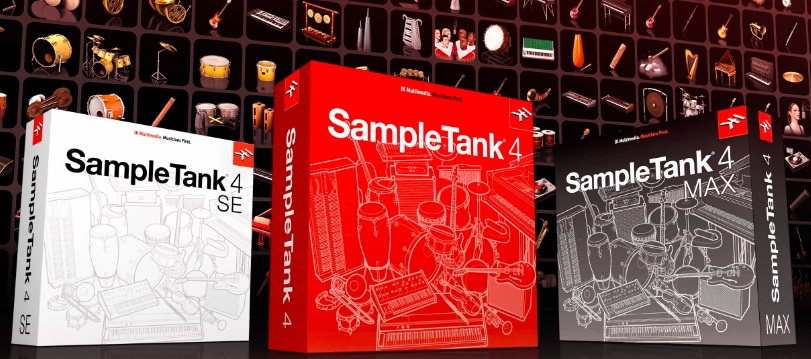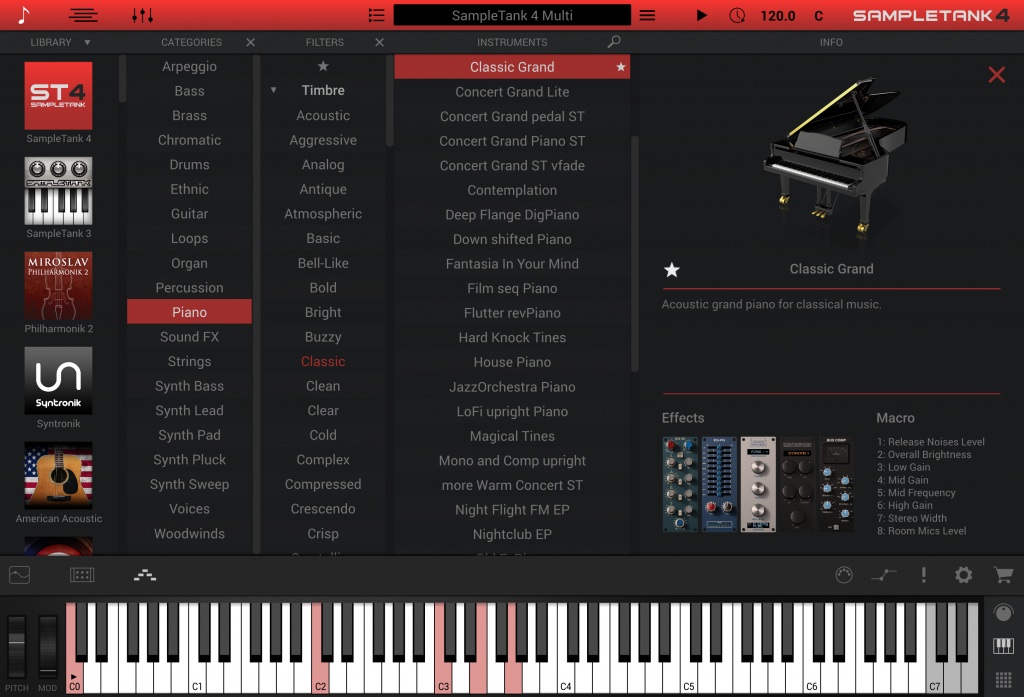New Software Review: SampleTank 4 by IK Multimedia

IK Multimedia furthers SampleTank with version 4, supercharged with scores of new features and a brand new user interface.
Well known for early and innovative music production tools like T-RackS, AmpliTube, and the virtual instrument collection SampleTank, IK Multimedia has been a pioneering force in creative software and music technology for over 20 years now.
Originally introduced in 2001, SampleTank quickly became a favorite among producers and engineers for its massive collection of realistic-sounding instruments. Now, SampleTank 4 is back and better than ever with a newly-designed interface, a new cutting-edge sound engine, and a massively expanded sample library with up to 260 GB of samples, loops, and effects.
SampleTank 4 is available in three versions: SampleTank 4 SE features 2,000 specially-chosen instruments, while SampleTank 4 includes 6,000 sounds, and SampleTank 4 MAX offers a whopping 8,000 sounds. This review was conducted using SampleTank 4 MAX. Click here to see the list of instruments included in each version.
Features
SampleTank 4 features two primary modes of operation: a default Play mode and Live Mode. Play mode is designed for writing and arranging, while Live Mode is tailor-made for live performances. Both modes give you access to a wide range of instruments, including acoustic piano and electric piano, bass, brass, chromatic, acoustic and electronic drums, ethnic, guitar, loops, organ, percussion, sound FX, strings, synths, voices, and woodwinds.
The default Play mode features three simple windows: Parts, Layer Editor, and Mixer.
The Parts window is where you build your arrangement. You can select instruments, assign them to different channels, and easily adjust things like volume, pan, mute, solo, and more. The Parts window features three sub-panels—Edit, Effects, and Player—which enable further tone shaping and customization.
You can further refine your sounds in the Edit panel, which lets you tweak every parameter of an instrument, including envelopes, LFOs, filters, and even modulation. You can fine-tune your tone in the Edit panel by selecting up to five effects per instrument. Choose from over 70 classic effects, including EQ, dynamics, reverb, delay, distortion, and more.
You can even use SampleTank to help write an arrangement. Just choose one of the four powerful signal generators in the Player panel to help you create the perfect arpeggios, guitar strums, MIDI patterns, and loops via the Loop Manager.
The Layers window makes it easy to create rich, complex soundscapes by layering sounds based on pitch, velocity, and more. In the Mixer window, you can add insert effects and send effects to each instrument, and even apply mix bus processing. Each Part has its own channel with standard channel strip controls, including volume, panning, mute, solo, and output assignment. SampleTank 4 is also available as a fully-functional standalone application that can be opened without a DAW.
In Use
As soon as you open SampleTank 4, you’re greeted by its inviting new interface. Adding sounds in the Parts panel is simple and intuitive; everything is neatly organized by library and category. Sounds can be filtered by timbre, style, genre, and mood, or searched for by name. The Parts panel also makes it easy to quickly create complex arrangements with controls for MIDI channel assignment and Transpose on each channel.
I must have spent an hour trying out different instruments, and I quickly lost track of how many times my jaw hit the floor in the process. The sounds are downright incredible. There are thousands of realistic-sounding, professionally recorded interments to choose from.
After finally deciding on an instrument (a synthesizer), I opened up the Edit panel. Here, you have nearly endless options for customization of any instrument, with advanced controls for every parameter of your sound. After increasing the attack of the synth by adjusting the amp envelope, adding some modulation with an LFO, and filtering the highs, I decided to give my sound the studio treatment with the Effects panel.
Many of the modules in the Effects panel will be instantly recognizable. I tried out all of the old classics, including EQs modeled after designs by Neve, API, and SSL, as well as 1176- and LA-2A-style compressors. To my delight, they all sounded and operated just like the originals.
After poorly playing a few melodies on my MIDI keyboard, I decided to give the Player panel a spin, which features an arpeggiator, a strummer, a “phraser”, and the Loop Manager. The arpeggiator operated as you would expect, and the strummer mimed some surprisingly realistic guitar playing. The Phraser lets you assign pre-recorded MIDI loops to your keyboard, which is great for beat-making, as is the Loop Manager. I was really impressed with all four players. They’re easy to use and full of creative inspiration.
Finally, I jumped over to the Mixer window to put the finishing touches on my tracks. I added channel effects, a couple send effects, and even some mix bus processing. I was actually really impressed with the mixer section—it’s really well-designed and felt natural to navigate and mix with.
To Be Critical
The first hurdle you’re likely to face with SampleTank 4 is the price. The MAX edition is quite a hit at $499.99—although there are discounts for those upgrading from SampleTank 3. However, for the number of instruments and effects you get, it’s actually kind of a steal. It just comes down to how likely you are to use the sounds in each bundle. MAX is great for composers and film scorers, but your average producer could easily survive on the high-quality instruments available in the standard or even SE version.
While using SampleTank 4 was easy and intuitive, installing SampleTank 4 was not. It takes more than just downloading the installer—each library must be downloaded individually.
The MAX edition came with so many sounds it would have taken days to download them all. Even if I did, it would have taken me years to actually use them all. It would be great if you could buy instruments a la carte, similar to IK’s T-RackS platform.
Summing it Up
Overall, I was extremely impressed with SampleTank 4. The sounds and effects are absolutely incredible, the interface is intuitive and easy to use, and it’s packed with handy features that I didn’t even know I wanted, like the Player panel and the modulation matrix.
My only gripes with SampleTank 4 MAX are with the price, which is justifiable for professionals, and the installation process—but for the number of amazing instruments you get, it’s totally worth it.
If you’re a producer, beat-maker, songwriter, composer, or creator of any kind, SampleTank 4 will surely be a welcome addition to your arsenal of sounds.
Brad Pack is an award-winning audio engineer and writer based in Chicago, IL. He currently owns and operates Punchy Kick, a professional mixing and mastering studio that specializes in pop punk, emo, punk, grunge, and alternative music.
He has been helping artists connect with fans through emotionally resonant mixes, cohesive masters, and insightful guidance for over 10 years. Check out his website PunchyKick.com or say hi on Instagram @PunchyKick.
Please note: When you buy products through links on this page, we may earn an affiliate commission.








[…] http://sonicscoop.com/2019/09/17/new-software-review-sampletank-4-by-ik-multimedia/ New Software Review: SampleTank 4 by IK Multimedia […]